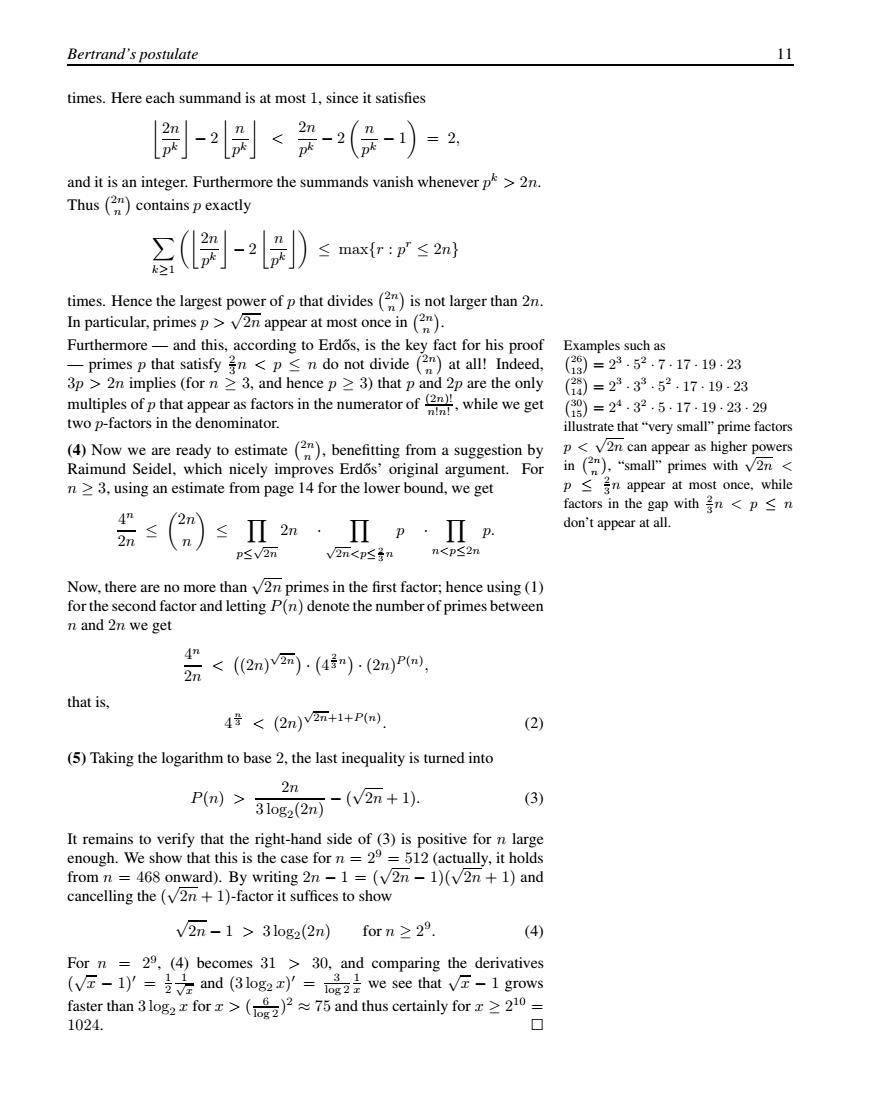正在加载图片...

Bertrand's postulate 11 times.Here each summand is at most 1,since it satisfies )=2 and it is an integer.Furthermore the summands vanish whenever p>2n. Thus(contains p exactly max{r:p'≤2n} times.Hence the largest power ofp that divides (is not larger than 2n. In particular,primes p2n appear at most once in () Furthermore-and this,according to Erdos,is the key fact for his proof Examples such as -primes p that satisfy<p<n do not divide (m)at all!Indeed, (9)=23.52.717.1923 3p>2 n implies(forn≥3,and hence p≥3)that p and2 p are the only (a)=23.33.52.171923 multiplesofp that appear as factors themtoofwhile we get (9)=24.32.517.19.23.29 two p-factors in the denominator. illustrate that"very small"prime factors (4)Now we are ready to estimate ()benefitting from a suggestion by p <V2n can appear as higher powers Raimund Seidel,which nicely improves Erdos'original argument.For in ()"small"primes with v2n< n>3,using an estimate from page 14 for the lower bound,we get p n appear at most once,while factors in the gap with in<p n 2n ≤Π2m·Πp·Πn don't appear at all. n P≤V②m V2n<p≤tn n<p≤2n Now,there are no more than v2n primes in the first factor;hence using(1) for the second factor and letting P(n)denote the number of primes between n and 2n we get 2元<(《2m))·(4n)-(2nPa, 4 that is, 4营<(2n)v2m+1+P(m) (2) (5)Taking the logarithm to base 2,the last inequality is turned into 2n P(n)>31og2(2m) -(V2m+1). (3) It remains to verify that the right-hand side of(3)is positive for n large enough.We show that this is the case for n =29=512 (actually,it holds from n =468 onward).By writing 2n-1 =(V2n-1)(V2n +1)and cancelling the (V2n+1)-factor it suffices to show v2n-1>31og2(2n) forn≥29. (4) For n =29,(4)becomes 31 30,and comparing the derivatives (W丘-1y=zamd(3log2xy=左we see that丘-1 grOws faster than 3og for)75 and thus certainly for0 1024. ▣Bertrand’s postulate 11 times. Here each summand is at most 1, since it satisfies 2n pk − 2 n pk < 2n pk − 2 n pk − 1 = 2, and it is an integer. Furthermore the summands vanish whenever pk > 2n. Thus 2n n contains p exactly k≥1 2n pk − 2 n pk ≤ max{r : pr ≤ 2n} times. Hence the largest power of p that divides 2n n is not larger than 2n. In particular, primes p > √2n appear at most once in 2n n . Furthermore — and this, according to Erdos, is the key fact for his proof ˝ — primes p that satisfy 2 3n<p ≤ n do not divide 2n n at all! Indeed, Examples such as 26 13 = 23 · 52 · 7 · 17 · 19 · 23 28 14 = 23 · 33 · 52 · 17 · 19 · 23 30 15 = 24 · 32 · 5 · 17 · 19 · 23 · 29 illustrate that “very small” prime factors p < √2n can appear as higher powers in 2n n , “small” primes with √2n < p ≤ 2 3n appear at most once, while factors in the gap with 2 3n<p ≤ n don’t appear at all. 3p > 2n implies (for n ≥ 3, and hence p ≥ 3) that p and 2p are the only multiples of p that appear as factors in the numerator of (2n)! n!n! , while we get two p-factors in the denominator. (4) Now we are ready to estimate 2n n , benefitting from a suggestion by Raimund Seidel, which nicely improves Erdos’ original argument. For ˝ n ≥ 3, using an estimate from page 14 for the lower bound, we get 4n 2n ≤ 2n n ≤ p≤√2n 2n · √2n<p≤ 2 3 n p · n<p≤2n p. Now, there are no more than √2n primes in the first factor; hence using (1) for the second factor and letting P(n) denote the number of primes between n and 2n we get 4n 2n < (2n) √2n · 4 2 3 n · (2n) P (n) , that is, 4 n 3 < (2n) √2n+1+P (n) . (2) (5) Taking the logarithm to base 2, the last inequality is turned into P(n) > 2n 3 log2(2n) − ( √ 2n + 1). (3) It remains to verify that the right-hand side of (3) is positive for n large enough. We show that this is the case for n = 29 = 512 (actually, it holds from n = 468 onward). By writing 2n − 1=(√2n − 1)(√ 2n + 1) and cancelling the ( √ 2n + 1)-factor it suffices to show √ 2n − 1 > 3 log2(2n) for n ≥ 29. (4) For n = 29, (4) becomes 31 > 30, and comparing the derivatives ( √x − 1) = 1 2 √ 1 x and (3 log2 x) = 3 log 2 1 x we see that √x − 1 grows faster than 3 log2 x for x > ( 6 log 2 )2 ≈ 75 and thus certainly for x ≥ 210 = 1024. ����